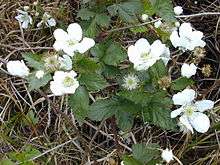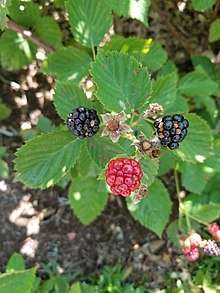Rubus argutus
Rubus argutus is a North American species of prickly bramble in the rose family. It is a perennial native to the eastern and south-central United States from Florida to Texas, Missouri, Illinois, and Maine.[2] Common names are sawtooth blackberry[3] or tall blackberry because of its habit of growing up to 2 meters (80 inches) in height.[4]
| Rubus argutus | |
|---|---|
 | |
 | |
| Scientific classification | |
| Kingdom: | Plantae |
| Clade: | Tracheophytes |
| Clade: | Angiosperms |
| Clade: | Eudicots |
| Clade: | Rosids |
| Order: | Rosales |
| Family: | Rosaceae |
| Genus: | Rubus |
| Species: | R. argutus |
| Binomial name | |
| Rubus argutus Link. 1822 | |
| Synonyms[1] | |
|
Synonymy
| |
Rubus argutus can be identified by a number of characteristics. These plants are typically woody shrubs or vines with thorns present on stems, leaves, and flowers. Leaves are alternate and palmately compound. First-year plants have palmate leaves with 5 leaflets while second-year plants have palmate leaves with 3 leaflets. Second-year plants develop racemes of flowers each containing five to twenty flowers. [5] The flowers are typically 5-merous with large, white petals and light green sepals, borne in mid-spring.[6] Second-year plants are also capable of growing the fruit which gives the plant's common name, the blackberry. The fruits are compound drupes which change from bright red to black at maturity. Each section (drupelet) of a blackberry contains a single seed. Second year plants die after bearing fruits, but regrow from the underground portion of the plant.
Blackberry leaves were in the official U.S. pharmacopoeia for a long time and were said to treat digestive problems, particularly diarrhea. Their dried leaves make an excellent tea even when you're healthy.[7]
There are many different species of blackberries. They are all edible and differ by size.[8]
References
- The Plant List, Rubus argutus Link
- County distribution map. Biota of North America Program 2014
- "Rubus argutus". Natural Resources Conservation Service PLANTS Database. USDA. Retrieved 24 October 2015.
- Rydberg, Per Axel (1901) Rubus argutus in Britton, Nathaniel, Manual of the Flora of the northern States and Canada. p. 498.
- "Highbush Blackberry". Illinois Wildflowers.
- Brainerd, Ezra (1900). "The Blackberries of New England". Journal of the New England Botanical Club. 2 (14): 23–29. JSTOR 23293072.
- "Blackberries, A Forager's Companion". Eat The Weeds and other things, too. 2014-05-07. Retrieved 2019-07-04.
- Bennett, Chris (2015-04-22). Southeast Foraging: 120 Wild and Flavorful Edibles from Angelica to Wild Plums. Timber Press. ISBN 9781604694994.
External links
| Wikimedia Commons has media related to Rubus argutus. |
- photo of herbarium specimen at Missouri Botanical Garden, collected in 1989 in Missouri
- US Wildflowers
